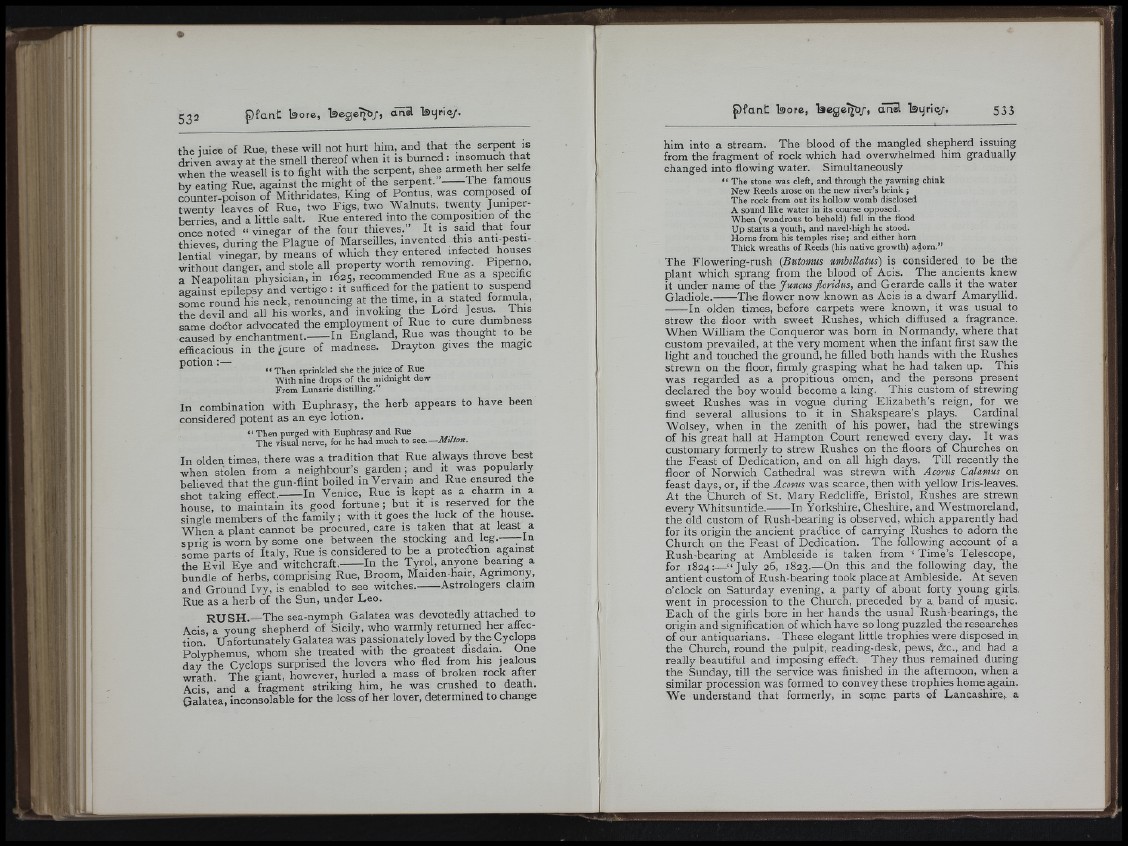
j '
r !
i i » i'
!
if
the iuice of Rue, these will not hurt him, and that the serpent is
driven away at the smell thereof when it is burned: insomuch that
when the weasell is to fight with the serpent, shee armeth her selfe
by eating Rue, against the might of the serpent. The fanious
counter-poison of Mithridates, King of Pontus, was composed of
twenty leaves of Rue, two Figs, two Walnuts, twenty Juniper-
berries, and a little salt. Rue entered into the composition of the
once noted “ vinegar of the four thieves. It is said that four
thieves, during the Plague of Marseilles, invented this anti-pesti-
lential vinegar, by means of which they entered infected houses
without danger, and stole all property worth removing. Piperno,
a Neapolitan physician, in 1625, recommended Rue as a specific
against epilepsy find vertigo : it sufficed for the patien to suspend
some round his neck, renouncing at the time, in a stated fornmla,
the devil and all his works, and invoking the Lord Jesus, ih is
same do^or advocated the employment of Rue to cure dumbness
caused by enchantment. In England, Rue was thought to be
efficacious in the ¿cure of madness. Drayton gives the magic
potion :— , . .
“ Then sprinkled she the juice of Kue
With nine drops of the midnight dew
From Lunarie distilling.”
In combination with Euphrasy, the herb appears to have been
considered potent as an eye lotion.
“ Then purged with Euphrasy and Rue
The visual nerve, for he had much to see.— Mtlion.
In olden times, there was a tradition that Rue always throve best
when stolen from a neighbour’s garden; and it was popularly
believed that the gun-flint boiled in Vervain and Rue ensured the
shot taking effect. In Venice, Rue is kept as a charm in a
house, to maintain its good fortune ; but it is reserved for the
single members of the family; with it goes the luck of the house.
When a plant cannot be procured, care is taken that at least a
spriR is worn by some one between the stocking and leg. - In
some parts of Italy, Rue is considered to be a proteaion against
the Ev^il Eye and witchcraft. In the Tyrol, anyone bearing a
bundle of herbs, comprising Rue, Broom, Maiden-hair, Agrimony,
and Ground Ivy, is enabled to see witches. Astrologers claim
Rue as a herb of the Sun, under Leo.
R U S H The sea-nymph Galatea was devotedly attached to
Acis, a young shepherd of Sicily, who warmly returned her affection.
Unfortunately Galatea was passionately loved by the Cycfeps
Polyphemus, whom she treated with the greatest disdain. One
day the Cyclops surprised the lovers who fled from his jealous
wrath The giant, however, hurled a mass of broken rock after
Acis, ’and a fragment striking him, he was crushed to death.
Galatea, inconsolable for the loss of her lover, determined to change
him into a stream. The blood of the mangled shepherd issuing
from the fragment of rock which had overwhelmed him gradually
changed into flowing water. Simultaneously
“ The stone was cleft, and through the yawning chink
New Reeds arose on the new river’s brink ;
The rock from out its hollow womb disclosed
A sound like water in its course opposed.
When (wondrous to behold) full in the flood
Up starts a youth, and navel-high he stood.
Horns from his temples rise; and either horn
Thick wreaths of Reeds (his native growth) adorn.”
The Flowering-rush {Butomus umhellatus) is considered to be the
plant which sprang from the blood of Acis. The ancients knew
it under name of the Juncus Jiondus, and Gerarde calls it the water
Gladiole. The flower now known as Acis is a dwarf Amaryllid.
In olden times, before carpets were known, it was usual to
strew the floor with sweet Rushes, which diffused a fragrance.
When William the Conqueror was born in Normandy, where that
custom prevailed, at the very moment when the infant first saw the
iight and touched the ground, he filled both hands with the Rushes
strewn on the floor, firmly grasping what he had taken up. This
was regarded as a propitious omen, and the persons present
declared the boy would become a king. This custom of strewing
sweet Rushes was in vogue during Elizabeth’s reign, for we
find several allusions to it in Shakspeare’s plays. Cardinal
Wolsey, when in the zenith of his power, had the strewings
of his great hall at Hampton Court renewed every day. It was
customary formerly to strew Rushes on the floors of Churches on
the Feast of Dedication, and on all high days. Till recently the
floor of Norwich Cathedral was strewn with Acorus Calamus on
feast days, or, if the Acorus was scarce, then with yellow Iris-leaves.
At the Church of St. Mary Redcliffe, Bristol, Rushes are strewn
every Whitsuntide. In Yorkshire, Cheshire, and Westmoreland,
the old custom of Rush-bearing is observed, which apparently had
for its origin the ancient pradtice of carrying Rushes to adorn the
Church on the Feast of Dedication. The following account of a
Rush-bearing at Ambleside is taken from ‘ Time’s Telescope,
for 1824:—“ Ju ly 26, 1823.—On this and the following day, the
antient custom of Rush-bearing took place at Ambleside. At seven
o’clock on Saturday evening, a party of about forty young girls,
went in procession to the Church, preceded by a band of music.
Each of the girls bore in her hands the usual Rush-bearings, the
origin and signification of which have so long puzzled the researches
of our antiquarians. These elegant little trophies were disposed ia
the Church, round the pulpit, reading-desk, pews, &c., and had a
really beautiful and imposing effedt. They thus remained during
the Sunday, till the service was finished in the afternoon, when a
similar procession was formed to convey these trophies home again.
We understand that formerly, in some parts of Lancashire, a
r\\